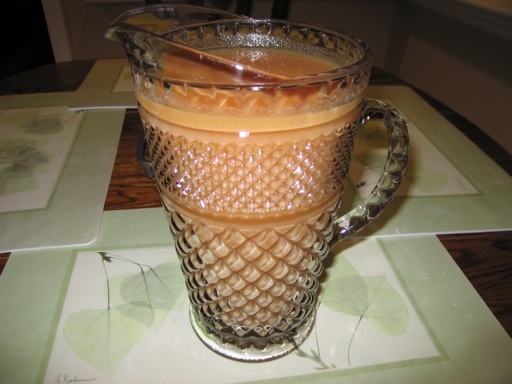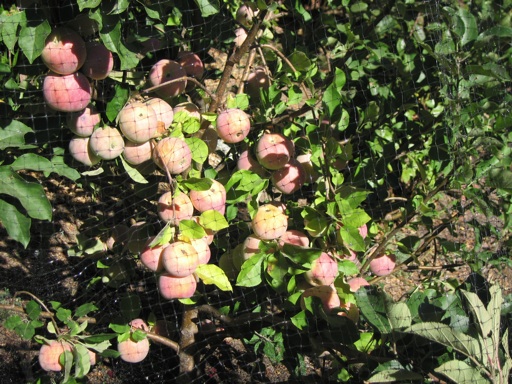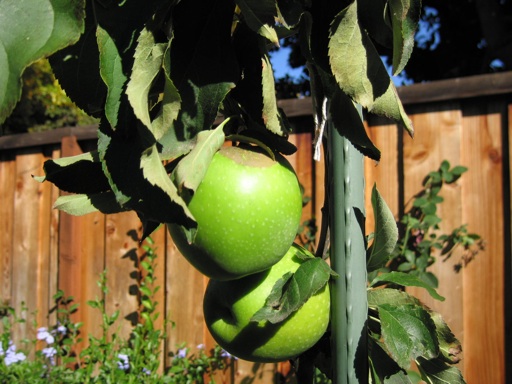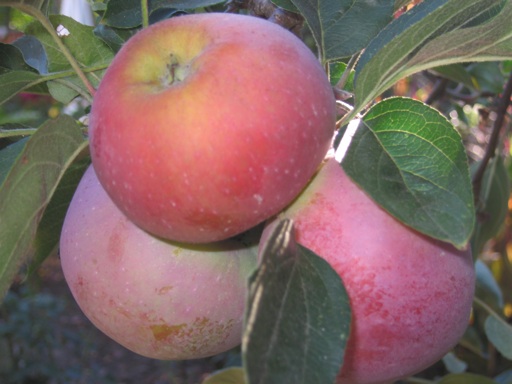Archive for the 'Apples' Category
What to do with all those apples from your backyard trees? Last month, my mom and I picked hundreds of apples from two 35 year old apple trees in my parents’ backyard. After making a few apple pies, I still had dozens of apples sitting in our refrigerator. Many of them were getting soft and had brown spots on them.
Today, I decided to juice the remaining apples (about 60 of them). We have a juicer device that we rarely use. I cored and sliced the apples, cutting out the brown spots, but not removing the skin. Then, I fed the apple slices through the juicer. Juice comes out one side and the skins come out the other. I made over a gallon of juice. I then heated the apple juice in a pot, and added some sugar and cinnamon, although the juice tasted very good by itself. It turned out very pulpy, which I don’t mind. Homemade juice can be diluted with water and/or strained through a sieve to make it more liquidy.

Below is a picture of the 5-year old Fuji apple tree in our backyard. It has about 100 apples this year, although they’re small. I’ve only picked a few of them so far. Last year, it had less apples (about 30), but they were larger. I’ve managed to keep the tree itself very small through pruning and not watering it too much to limit its growth. It’s a semi-dwarf tree that has the potential to grow over 20 feet tall. It’s currently only about 6′ tall x 6′ wide, so it’s still very easy to net and harvest the fruit. Apples of course are well known for growing into very large trees. However, so far I’ve found that at least some varieties of apples are easy to keep small. They still produce a significant amount of fruit despite their small size.

We also have a very small Granny Smith apple tree, which was full of apples a month ago. But I ended up pulling off about 70% of the apples because the branches were sagging to near breakage under the weight of the fruit.
September 15 2012 | Apples | Comments Off on Homemade Apple Juice

I planted a granny smith apple tree transplant in our yard in 2006. It’s a scrawny little tree. It hasn’t grown much since I planted it, even though I have been watering it regularly and fertilizing it twice a year. Even so, I have high hopes that it will undergo a growth spurt eventually.
This tree produced about 8 apples this season. The apples are large enough to cause the tree’s weak branches to sag down toward the ground. A few of the branches have broken off under the weight of just one or two apples. The tree has so few branches that some of the apples got sunburned in the summertime.
I picked granny smith partly because it has a lower chill requirement than most apples and partly because I like the flavor. The granny smith apple flavor is slightly tart, at least when it is fully ripe. People who think that granny smith apples are supposed to be extremely tart have never eaten a fully ripened one. I think that the flavor is like a very mild version of a tart green apple candy.
Some sources say that granny smith apples should be picked in September. But I have heard that they are best left on the tree until after November 1, weather permitting. Last year, I harvested them the first week of November, and they were only slightly tart. Most of them had a great flavor, although a few were bland. This year, I am leaving them on the tree a few weeks longer to see what difference, if any, a few extra weeks would make. I have harvested a few so far, and they taste about the same as last year.
November 17 2008 | Apples | Comments Off on Granny Smith Apples

August is Gravenstein apple season in California. Gravenstein apples have been a popular apple here in Northern California for a long time. They are excellent apples for making apple pie and apple sauce, because they have a balanced sweet-tart flavor, and they soften up when cooked.
This is a picture of Gravenstein apples ripening on a small tree in our yard. It’s interesting how red the apples are turning. The apples on my mom’s Gravenstein apple tree are usually yellow with a bit of a red blush. Hers rarely turn this red. There is a variety of apple tree called Red Gravenstein, but our tree was labeled as a regular Gravenstein.
Apple trees are not self-fertile. At least two different varieties of apple trees need to be grown within about 100 feet of each other to achieve successful cross-pollination. Apple trees may not bear apples without proper cross-pollination between two different types of apples. Sometimes an apple tree that is not cross-pollinated produces very small apples or very few apples.
We also have a small Fuji apple tree and a small Granny Smith apple tree. Why three apple trees? Gravenstein apple trees have sterile pollen, which means that a Graventstein will not pollenate the blossoms of another apple tree. Without a third tree, the second tree would not get pollenated. The second apple tree pollenates the Gravenstein and the third apple tree, and the third apple tree pollenates the second apple tree.
Most apples ripen in the late summer or fall. For example, Fuji and Granny Smith apples usually ripen in October into early November. One of the great things about Gravenstein apples is that they ripen early, a month or two before most apples. So we are harvesting apples in the summer and in the fall.
August 03 2008 | Apples | Comments Off on Gravenstein Apple Season



